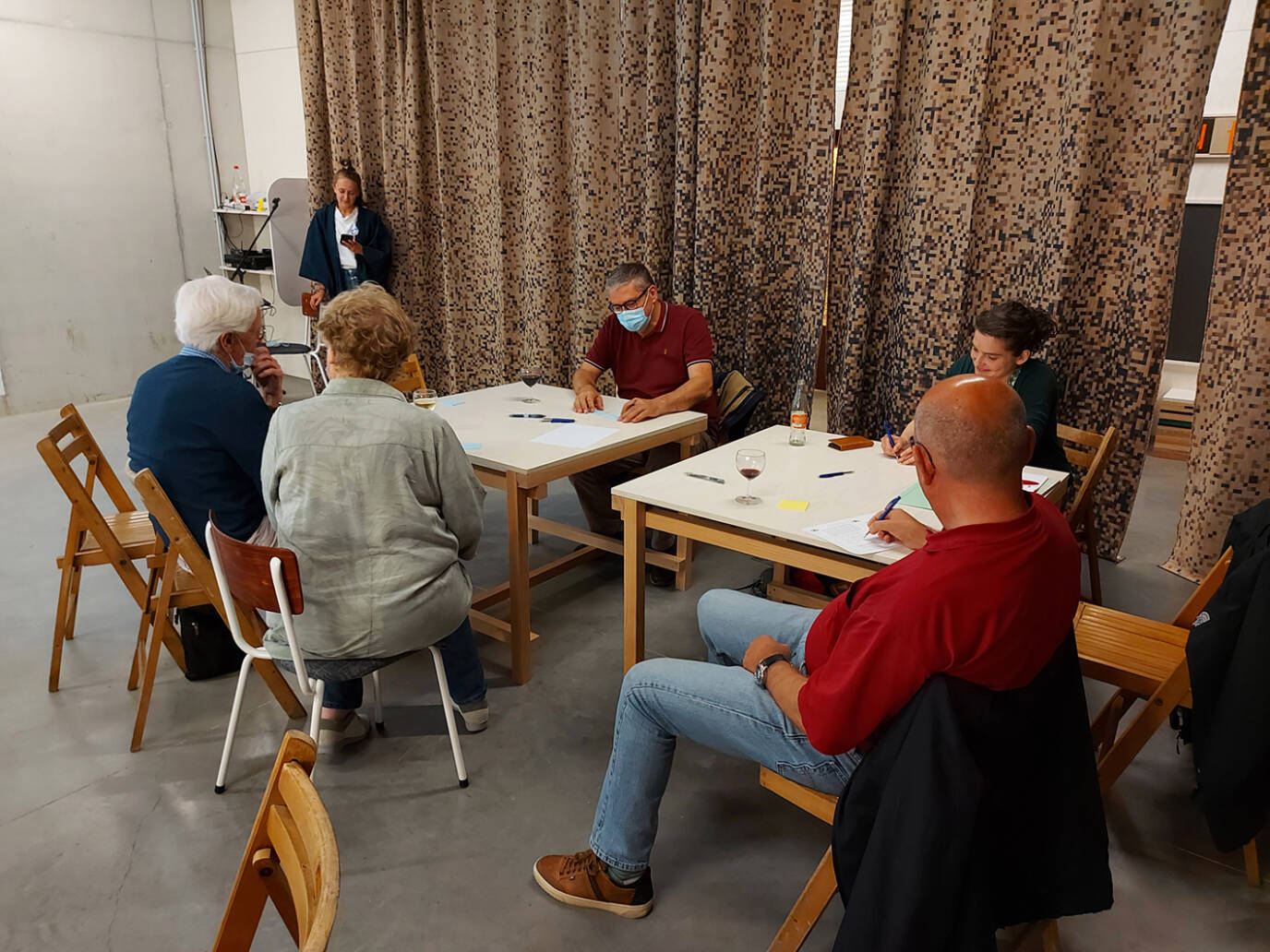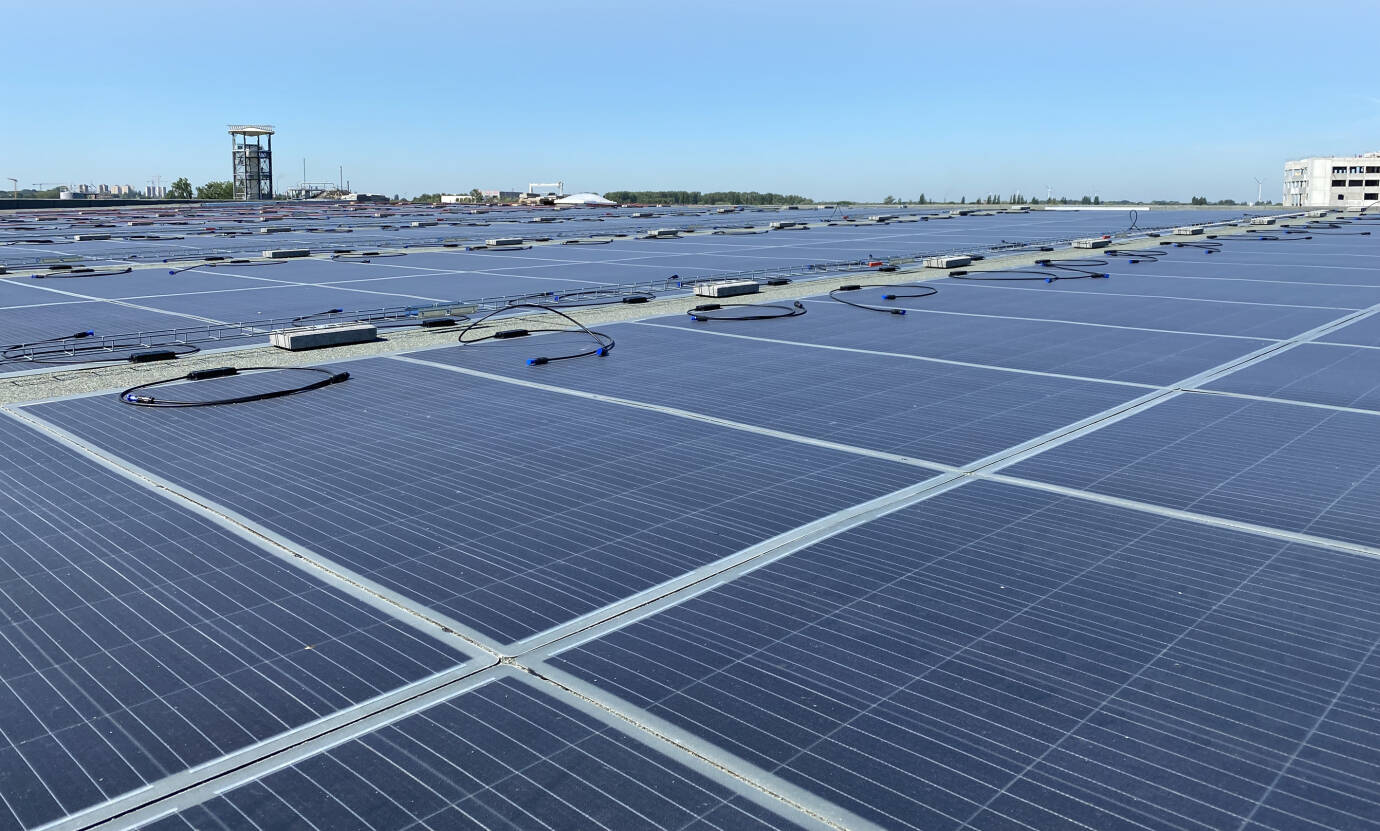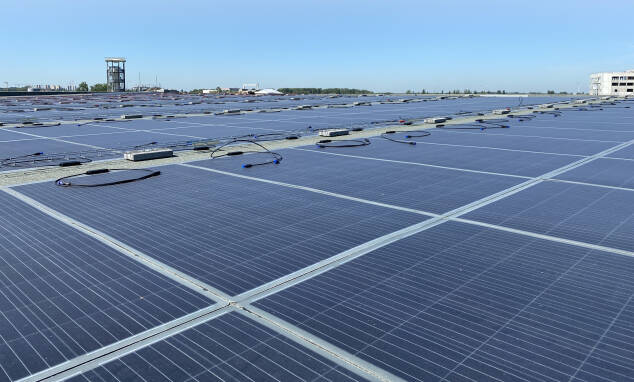

SCROLL

The members of the neighbourhood energy group and interested residents were kept informed about the solar panel projects and participated in discussions about the structure and content of the energy group via:
• 5 energy cafés
• 4 workshops with interesting sustainable projects


4.2. Community solar panels
Do apartment residents want to switch to renewable energy? At first glance, solar panels may not necessarily appear to be the best choice. The surface area of the roof of an apartment building is limited and there is barely any room for batteries. As such, we chose to pursue community solar panels, set up in four locations: the roof of an office building in New South, the façade of the Fluvius heat plant, the roof of service centre Hof ter Beke Antwerpen and the roof of the Kielsbroek wholesale market .
How do community solar panels work? In our case, Ecopower rented the roofs of the four locations for a period of twenty years. Residents from New South have the opportunity to enter into a neighbourhood energy cooperative. The members invest in the installation and become part-owners. They do this by purchasing shares. In doing so, the apartment residents without any roof space of their own also benefit from solar energy. The energy produced that is not used locally is sold.
The income from this sale flows back to the cooperative in the form of a sustainability budget of approximately 15,000 euros per year. The group uses this to invest in new, sustainable projects in and around New South, such as charging stations for electric vehicles and bikes, electric share-cars and communal gardens ...
App uses simulations
Via Circular South, the residents could have free smart meters installed. Because the installation of our own solar installations was delayed, the app simulated the energy production of solar panels on the buildings of VITO/EnergyVille in Genk. In the app, the residents saw when there was most solar energy available, monitored their own use and could compare with the other residents.
Energy Cafés
© CIRCULAIR ZUID






The results
Difficulties during the process
TECHNOLOGY

A difficult tender process: We needed three tenders to come to a framework contract for the supply of the solar panels and batteries. No one presented themselves as candidates in response to the first tender. The second consortium fell apart. The third tender, in which the requirements for the BIPV system were made more flexible, was successful.
Too little courage or audacity among the building partners: The architects of the buildings in New South put the emphasis on classic green roofs and green terraces, and mostly chose to use solar panels as they are barely visible. In the end, the project developer did not make any roofs and façades available for solar panels. As such, the project had to look for new locations. This search was made more difficult by delays in construction, resistance from the owners of the roofs, roofs that were not stable enough, and other issues. It proves that a lot of architects and builders lack knowledge about sustainability at this point in time. And that raising awareness needs to begin in the very first phase of the building process.
Limited interest among the residents: Circular South assumed that people who consciously chose a new-build home in a sustainable neighbourhood would be prepared to invest extra in PV panels, BIPV systems and batteries. However, there were several residents who had no interest, too little confidence, or who dropped out because of the difficult process. At the start of the project, there were very few people actually living in the district. As such, we did not have any large groups.
Limited returns: Although sustainability and circularity are about much more than the returns nowadays, a lot of people looked primarily at how they could benefit. And that financial return appeared to be too low to encourage a lot of people to become involved. We noticed that participants used the app to follow how much money they were saving with their energy use; this was not the goal of the project.
Missing legislation: The project wanted residents to be able to directly share their individual energy excesses with other residents instead of reinjecting them into the distribution net. There is an exception being made to the electricity regulations that will allow this. The problem was that this legislative exclusion was not ready during the project. The partners of the Circular South project pushed for adjusted legislation that made it easier for local energy networks to be established. In this way, users are encouraged to only use energy when it’s available in full.
COVID-19: The coronavirus pandemic often threw a spanner in the works, but most particularly with the decision made about the installation of community solar panels. These were installed on roofs or façades of a number of large buildings where the association of co-owners (ACO) had the authority to decide. For Ecopower to hire the roofs to install the energy installation, we needed the unanimous approval of the ACO. But as a result of the coronavirus crisis, the ACO were no longer meeting. As such, gaining this approval was particularly difficult.
© ECOPOWER
The results
4.2. Community solar panels
Do apartment residents want to switch to renewable energy? At first glance, solar panels may not necessarily appear to be the best choice. The surface area of the roof of an apartment building is limited and there is barely any room for batteries. As such, we chose to pursue community solar panels, set up in four locations: the roof of an office building in New South, the façade of the Fluvius heat plant, the roof of service centre Hof ter Beke Antwerpen and the roof of the Kielsbroek wholesale market .

© ECOPOWER
How do community solar panels work? In our case, Ecopower rented the roofs of the four locations for a period of twenty years. Residents from New South have the opportunity to enter into a neighbourhood energy cooperative. The members invest in the installation and become part-owners. They do this by purchasing shares. In doing so, the apartment residents without any roof space of their own also benefit from solar energy. The energy produced that is not used locally is sold.
The income from this sale flows back to the cooperative in the form of a sustainability budget of approximately 15,000 euros per year. The group uses this to invest in new, sustainable projects in and around New South, such as charging stations for electric vehicles and bikes, electric share-cars and communal gardens ...






The members of the neighbourhood energy group and interested residents were kept informed about the solar panel projects and participated in discussions about the structure and content of the energy group via:
• 5 energy cafés
• 4 workshops with interesting sustainable projects
A difficult tender process: We needed three tenders to come to a framework contract for the supply of the solar panels and batteries. No one presented themselves as candidates in response to the first tender. The second consortium fell apart. The third tender, in which the requirements for the BIPV system were made more flexible, was successful.
Too little courage or audacity among the building partners: The architects of the buildings in New South put the emphasis on classic green roofs and green terraces, and mostly chose to use solar panels as they are barely visible. In the end, the project developer did not make any roofs and façades available for solar panels. As such, the project had to look for new locations. This search was made more difficult by delays in construction, resistance from the owners of the roofs, roofs that were not stable enough, and other issues. It proves that a lot of architects and builders lack knowledge about sustainability at this point in time. And that raising awareness needs to begin in the very first phase of the building process.
Limited interest among the residents: Circular South assumed that people who consciously chose a new-build home in a sustainable neighbourhood would be prepared to invest extra in PV panels, BIPV systems and batteries. However, there were several residents who had no interest, too little confidence, or who dropped out because of the difficult process. At the start of the project, there were very few people actually living in the district. As such, we did not have any large groups.
Limited returns: Although sustainability and circularity are about much more than the returns nowadays, a lot of people looked primarily at how they could benefit. And that financial return appeared to be too low to encourage a lot of people to become involved. We noticed that participants used the app to follow how much money they were saving with their energy use; this was not the goal of the project.
Missing legislation: The project wanted residents to be able to directly share their individual energy excesses with other residents instead of reinjecting them into the distribution net. There is an exception being made to the electricity regulations that will allow this. The problem was that this legislative exclusion was not ready during the project. The partners of the Circular South project pushed for adjusted legislation that made it easier for local energy networks to be established. In this way, users are encouraged to only use energy when it’s available in full.
COVID-19: The coronavirus pandemic often threw a spanner in the works, but most particularly with the decision made about the installation of community solar panels. These were installed on roofs or façades of a number of large buildings where the association of co-owners (ACO) had the authority to decide. For Ecopower to hire the roofs to install the energy installation, we needed the unanimous approval of the ACO. But as a result of the coronavirus crisis, the ACO were no longer meeting. As such, gaining this approval was particularly difficult.
App uses simulations
Via Circular South, the residents could have free smart meters installed. Because the installation of our own
solar installations was delayed, the app simulated the energy production of
solar panels on the buildings of VITO/EnergyVille in Genk. In the app,
the residents saw when there was most solar energy available, monitored their own use and could compare with the other residents.
Energy Cafés
Difficulties during the process

© CIRCULAIR ZUID

